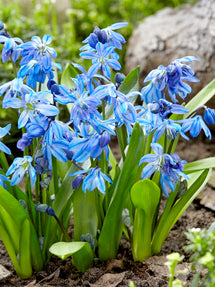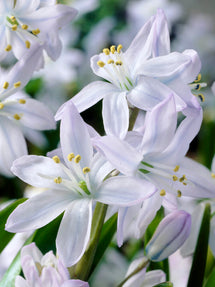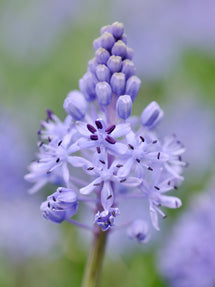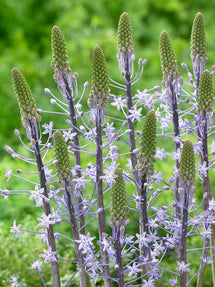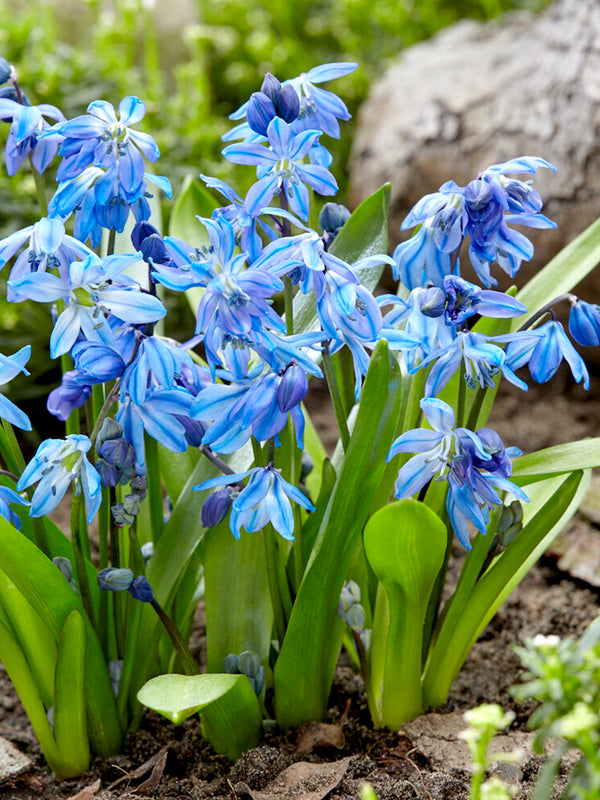Scilla (Squill)
Scilla, often called Squill, brings a sea of color to your garden in the early spring. The flowers are usually blue, but they can also be white or a delicate pink. These graceful blooms emerge just as winter comes to an end, adding life and color when few other flowers are in bloom. A drift of Scilla bulbs looks wonderful when planted on lawns, under trees or shrubs, at the edge of woodland areas, or throughout a rock gardens.
Showing 1 - 5 in 5 items
SCILLA - siberian squill FLOWER BULBS FROM HOLLAND
Scilla: The Spring Beauty Of Your Garden That Naturalizes Quickly
The genus Scilla belongs to the Hyacinthaceae family, a large genus of bulbous perennials native to Europe, North Africa, and parts of Central and Western Africa. Various Scilla species can be found in these regions. In early spring, you’ll notice its slender, strappy leaves emerging, followed closely by delicate spikes of nodding, bell-shaped or starry flowers. Scilla varieties primarily display a vibrant light blue hue, though white or pink petals can also be observed. They have a delightful fragrance and also make a lovely cut flower, adding charm and perfume to any spring bouquet or floral arrangement.
What sets Scilla apart is its remarkable ability to naturalize quickly. Once planted in your garden, these flower bulbs return every spring, spreading gently and multiplying on their own without extra effort, forming large colonies over time. When Squill bulbs have found their happy spot, they can naturalize through both bulb offsets (baby bulbs that grow from the sides of the original bulb) and by self-sowing seeds. Unlike so many plants, achieving a lasting charm in your spring garden or landscape is relatively quick and easy.
Outstanding Scilla Types: From Scilla Siberica To Scilla Bifolia
When choosing Scilla for your garden, two varieties stand out for their performance, beauty, and ease of care: Scilla “Siberica” and Scilla “Bifolia”. Both are compact, reaching up to 6 inches tall, and are generally deer-resistant and rabbit-resistant. They have a light fragrance and thrive in the ground or in pots and containers. They grow best in USDA zones 3–8 in the early spring, so you can enjoy their charm for many years to come.
- Scilla “Siberica”: Scilla Siberica, also known as “Siberian Squill”, is a well-known blue Squill. Its vivid sky-blue, bell-shaped flowers bloom early and naturalize quickly. Scilla Siberica bulbs grow in neat, compact clumps and reliably return each spring with even more blooms. It’s an ideal choice for borders, rock gardens, or under trees. Read more about this variety in our article about Siberian Squill.
- Scilla “Tubergeniana”: This variety, also known as Scilla “Mischtschenkoana” or “White Squill”, has a distinctive appearance. Its large, white florets appear in dense clusters on short spikes, adding brightness and contrast to your garden. It’s perfect for small spaces, containers, or as a refined edging plant.
Other beautiful varieties include the Scilla “Campanulata”, which has bright blue petals with dark blue veins, and the Scilla “Bifolia”, which produces starry, gentian-blue flowers. Are you looking for a variety that blooms in late spring and early summer? Scilla “Peruviana” with its violet petals is an excellent choice.
How To Plant Scilla Bulbs For Maximum Effect
Depending on the zone you live in, Squill bulbs are planted in early to late fall. In the spring, you will be rewarded with charming blue or white flowers. To achieve this, proper planting is essential. Follow our growing guide “How to Grow Scilla Bulbs” or the tips below for the best results.
Select a location with well-draining soil conditions and part shade. For example, choose the east side of your garden. Full sun is also fine as long as the soil doesn’t dry out completely in the summer. Do you want to grow Scilla bulbs in a flower bed? Space them 4 inches apart for even coverage. In containers, you can place them a little closer together for a denser look. Next, dig a hole that is 2–3 inches deep and at least twice the height of the soil above the bulbs. Place one bulb in each hole with the pointed end facing up, then cover with soil. Once planted, water well to help settle the soil around the bulbs.
After blooming in the early spring, the Scilla plant enters a period of rest. The leaves will turn yellow and die back; this is a normal process. You can remove the old foliage at this stage. For a longer spring display, consider planting Scilla alongside other plants, such as spring ephemerals like Snowdrops, Crocuses, Daffodils, or Glory-of-the-Snow, to create layered blooms that complement each other beautifully.
Top-Quality Scilla Bulbs For Sale At DutchGrown
Scilla’s ability to multiply over time makes it a favorite among gardeners looking to create a soft, colorful display that brightens the garden in early spring. For optimal results, the size of the bulbs is crucial. At DutchGrown, you'll find a selection of the finest Squill bulbs (3 inches), delivering reliable performance and stunning results. Each variety is carefully chosen for quality, vigor, and garden success. Browse our collection of early spring flowers and shop your favorite Scilla varieties for the upcoming season. We ship throughout the US.
Frequently Asked Questions About Scilla
Do Scilla Bulbs Spread?
Scilla bulbs naturally spread in your garden. They multiply through bulb offsets and self-sown seeds, creating a fuller display each spring with minimal effort. When planted in the right spot, Scilla forms beautiful drifts of color that expand over time. This naturalizing habit makes Scilla a favorite for borders, under trees, and in naturalized garden areas.
Will Squill Grow In The Shade?
Squill does not perform optimally in full shade. Growth may slow down, and flowering may be limited. Instead, the plant prefers partial shade. It can also grow in full sun, as long as the soil doesn’t dry out completely in the summer. For the best results, plant Squill in an area that receives plenty of sunlight during the day. This will help the bulbs develop strong foliage and ensure a vibrant spring bloom.
Do Scilla Come Back Every Year?
Scilla will come back every spring season when provided with proper care and suitable conditions. With well-draining soil and partial to full sun exposure, they reliably bloom year after year. Over time, Scilla not only returns but also multiplies, spreading through bulb offsets and seeds.
Where Is The Best Place To Plant Scilla?
The best place to plant Scilla is in both garden beds and containers. Choose a location with well-drained soil and partial shade. Full sun is also fine, as long as the soil doesn’t dry out completely in the summer. Scilla is hardy in USDA zones 3–8 and thrives in naturalized settings. For a soft, seasonal burst of color, try planting it in drifts across a lawn, under deciduous trees, along native woodland edges, or in rock gardens.
